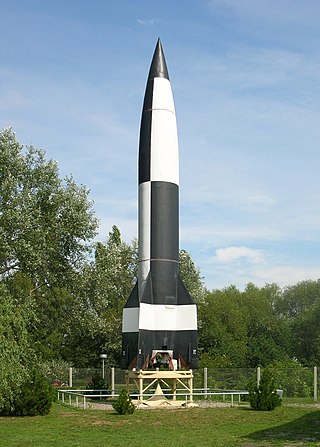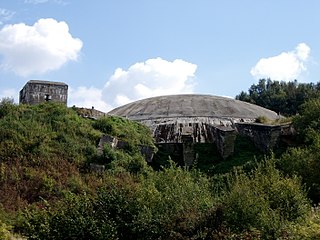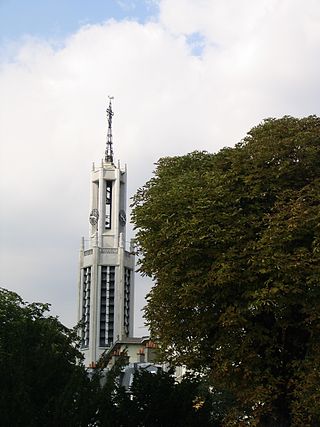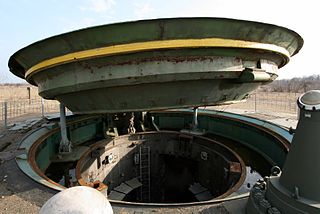
Staveley Road is a road in the Grove Park district of Chiswick in the London Borough of Hounslow. It was the site of the first successful V-2 missile attack against Britain.

Staveley Road is a road in the Grove Park district of Chiswick in the London Borough of Hounslow. It was the site of the first successful V-2 missile attack against Britain.

Staveley Road was built between 1927 and 1931 as part of the Chiswick Park Estate.
On Friday 8 September 1944, a V-2 launched from Wassenaar in Holland, by 485 Artillerie Abteilung at 6.37pm, [1] landed in Staveley Road near the junction with Burlington Lane, killing three people (including a three-year-old girl), and injuring nineteen. [2] The crater was thirty feet across. Earlier that day at 8.39am, a V2 had hit Maisons-Alfort in France, where six people were killed; the V2 had been launched from Petites-Tailles, near Houffalize, in south-east Belgium by Lehr und Versuchsbatterie 444. [3]
Eleven houses were completely destroyed, and another fifteen had to be extensively rebuilt. The area at the time had been partly evacuated. The explosion could be heard six miles away in central London. Within an hour of the explosion, government officials were arriving at the scene.
The explosion has been shown in the 2015 production Hitler's Space Rocket, [4] produced with ZDF of Germany, and in the 1965 film Operation Crossbow .
General Wilhelm Ritter von Thoma discreetly mentioned to General Ludwig Crüwell about the V-2, when being bugged by MI19, so disclosing the rocket's propensity on 22 March 1943 - this was the first occasion that the British knew. Fritz Lustig, father of Radio 4's Robin Lustig, was one of the translators.
RV Jones received most of his information on the V2 from the French spy Jeannie Rousseau.
The general public was not notified about the existence of V-2 rockets until 10 November 1944.

The Peenemünde Army Research Center was founded in 1937 as one of five military proving grounds under the German Army Weapons Office (Heereswaffenamt). Several German guided missiles and rockets of World War II were developed by the HVP, including the V-2 rocket. The works were attacked by the British in Operation Crossbow from August 1943, before falling to the Soviets in May 1945.

The V2, with the technical name Aggregat 4 (A4), was the world's first long-range guided ballistic missile. The missile, powered by a liquid-propellant rocket engine, was developed during the Second World War in Nazi Germany as a "vengeance weapon" and assigned to attack Allied cities as retaliation for the Allied bombings of German cities. The V2 rocket also became the first artificial object to travel into space by crossing the Kármán line with the vertical launch of MW 18014 on 20 June 1944.

The V-1 flying bomb was an early cruise missile. Its official Reich Aviation Ministry (RLM) designation was Fieseler Fi 103 and its suggestive name was Höllenhund (hellhound). It was also known to the Allies as the buzz bomb or doodlebug and in Germany as Kirschkern or Maikäfer (maybug).

Major-General Dr. Walter Robert Dornberger was a German Army artillery officer whose career spanned World War I and World War II. He was a leader of Nazi Germany's V-2 rocket programme and other projects at the Peenemünde Army Research Centre. After the war, the US Nazi scientist recruitment programme Operation Paperclip saw him move to the US, largely avoiding punishment for involvement in war crimes, to work for some decades in high positions in aerospace, including for Bell Aircraft and Boeing.

La Coupole, also known as the Coupole d'Helfaut-Wizernes and originally codenamed Bauvorhaben 21 or Schotterwerk Nordwest, is a Second World War bunker complex in the Pas-de-Calais department of northern France, about 5 kilometres (3.1 mi) from Saint-Omer, and some 14.4 kilometers south-southeast from the less developed Blockhaus d'Éperlecques V-2 launch installation in the same area. It was built by the forces of Nazi Germany between 1943 and 1944 to serve as a launch base for V-2 rockets directed against London and southern England and is the earliest known precursor to modern underground missile silos still in existence.

Operation Backfire was a military scientific operation of the Western Allies during and after the Second World War that was performed mainly by British personnel. The operation was designed to completely evaluate the entire V-2 rocket assembly, interrogate German personnel specialized in all phases of it, and then to test and launch missiles across the North Sea.

Crossbow was the code name in World War II for Anglo-American operations against the German long range reprisal weapons (V-weapons) programme. The primary V-weapons were the V-1 flying bomb and V-2 rocket, which were launched against Britain from 1944 to 1945 and used against continental European targets as well.

Maisons-Alfort is a commune in the southeastern suburbs of Paris, France. It is located 8.4 km (5.2 mi) from the center of Paris.

V-weapons, known in original German as Vergeltungswaffen, were a particular set of long-range artillery weapons designed for strategic bombing during World War II, particularly strategic bombing and/or aerial bombing of cities. They were the V-1, a pulsejet-powered cruise missile; the V-2, a liquid-fueled ballistic missile; and the V-3 cannon. Germany intended to use all of these weapons in a military campaign against Britain, though only the V-1 and V-2 were so used in a campaign conducted 1944–45. After the invasion of western Europe by the Allies, these weapons were also employed against targets on the mainland of Europe, mainly in France and Belgium. Strategic bombing with V-weapons killed approximately 18,000 people, mostly civilians. The cities of London, Antwerp and Liège were the main targets.
The Rocket U-boat was a series of military projects undertaken by Nazi Germany during the Second World War. The projects, which were undertaken at Peenemünde Army Research Center, aimed to develop submarine-launched rockets, flying bombs and missiles. The Kriegsmarine did not use submarine-launched rockets or missiles from U-boats against targets at sea or ashore. These projects never reached combat readiness before the war ended.

Operation Most III or Operation Wildhorn III was a World War II operation in which Poland's Armia Krajowa provided the Allies with crucial intelligence on the German V-2 rocket.

The Blockhaus d'Éperlecques is a Second World War bunker, now part of a museum, near Saint-Omer in the northern Pas-de-Calais département of France, and only some 14.4 kilometers north-northwest from the more developed La Coupole V-2 launch facility, in the same general area.

Operation Hydra was an attack by RAF Bomber Command on a German scientific research centre at Peenemünde on the night of 17/18 August 1943. Group Captain John Searby, commanding officer of No. 83 Squadron RAF, commanded the operation, the first time that Bomber Command used a master bomber to direct the attack of the main force. Hydra was the first operation against the German V-weapon programme, a campaign later known as "Crossbow". The British lost 40 bombers and 215 aircrew, and several hundred enslaved workers in the nearby Trassenheide forced labour camp were killed. The Luftwaffe lost twelve night-fighters and about 170 German civilian personnel were killed, including two V-2 rocket scientists. Assessments of the raids effectiveness vary; the United States Strategic Bombing Survey (1945) called the raid "not effective", while in 2006 the historian Adam Tooze judged that it had been highly successful.
"Big Ben" was the World War II code name for the British project to reconstruct and evaluate captured German missiles such as the V-2 rocket. On 31 July 1944, after the UK agreed to exchange Supermarine Spitfires for the wreckage of a V-2 in Sweden during World War II, experts at Farnborough began an attempt to reconstruct the missile.

A missile launch facility, also known as an underground missile silo, launch facility (LF), or nuclear silo, is a vertical cylindrical structure constructed underground, for the storage and launching of intercontinental ballistic missiles (ICBMs), intermediate-range ballistic missiles (IRBMs), medium-range ballistic missiles (MRBMs). Similar facilities can be used for anti-ballistic missiles (ABMs).

Military intelligence on the V-1 and V-2 weapons developed by the Germans for attacks on the United Kingdom during the Second World War was important to countering them. Intelligence came from a number of sources and the Anglo-American intelligence agencies used it to assess the threat of the German V-weapons.

V-2 rocket facilities were military installations associated with Nazi Germany's V-2 SRBM ballistic missile, including bunkers and small launch pads which were never operationally used.

The Blizna V-2 missile launch site was the site of a World War II German V-2 missile firing range. Today there is a small museum located in the Park Historyczny Blizna in Blizna, Poland. After the RAF strategic bombing of the V-2 rocket launch site in Peenemünde, Germany, in August 1943, some of the test and launch facilities were relocated to Blizna in November 1943. The first of 139 V-2 launches was carried out from the Blizna launch site on 5 November 1943.

Sottevast was a Second World War bunker complex for launching V2-weapons in Sottevast near Cherbourg, in Normandy, France. It was built, under the codename Reservelager West, by the forces of Nazi Germany between 1943 and 1944 to serve as a launch base for V-2 rockets directed against southern England.